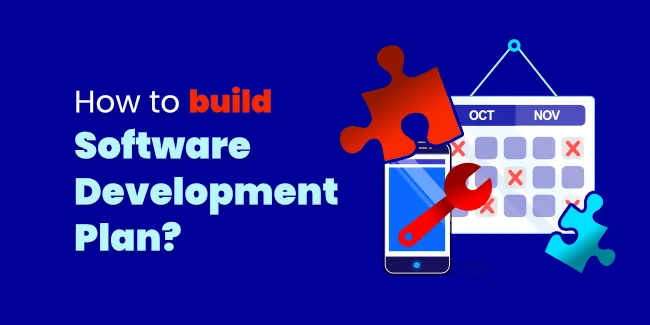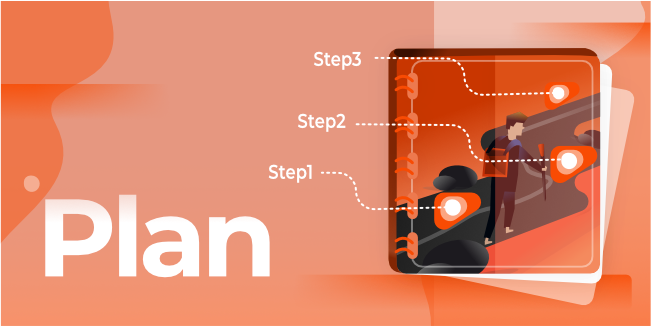How To Build Software Development Plan (2022)

The process of software application development is highly complicated. It's something that happens regardless of whether you create software for clients all over the world or develop your software programs. And sadly, this occurs way too frequently in today's tech sectors.
When the customer is not technical, it might not be easy to convey why things didn't go as planned or to persuade them why you need additional resources. The client may be perplexed as to why a project can't be finished on time and within budget, even though your developers' best efforts are made.
When you work on your software development project, reducing cycle time, increasing predictability, and minimizing irritations among your developers will help you get projects done faster.
Because no matter how simple or complicated the job is, you need a solid project plan. It's the answer to having a clear structure, documentation, and processes in place so that you can complete tasks efficiently and deliver high-quality software on time.
If you would like to create a software development plan for your project, get to know our Discovery Workshop, on which we help our clients create stable foundations for their projects.
What is Software Development Project Plan?
A software development plan is a method for managing a software project. It explains the tasks and resources required to complete the project successfully.
The timeline of a development project is covered in software development planning. The plan covers all of the phases of the procedure, including analysis and planning, ideation, design and development, deployment, production and launch, and maintenance.
Planning software development projects effectively entails documenting and covering everything from the beginning, project description, and requirements to a clear timetable of the timeline, project monitoring, planned results, costs and resources evaluation, risk management, and anything in between.
That is why the quality of the project is strongly influenced by how well the software project plan is created. It also enables optimal resource allocation, exactly where it's needed. You risk having too many obstacles to overcome during the process if you don't create a schedule, resulting in delays, additional expenses, consumer dissatisfaction, low morale, and low team productivity.
As a result, everyone involved in software development project planning must be skilled in effective planning: project managers, product owners, stakeholders, project team members, development team, and managers included.
Ideally, a project manager works with the designated team in tandem with stakeholders and other departments that have a part in the project's success - such as testing or QA teams or marketing experts.
Benefits of Creating Software Development Plan
The advantages of today's software project planning are enormous. Not only would you have a clear process in place for everyone, but you'd also produce more time and cost-effective, trustworthy software in a far less stressful manner, both for the supplier and client teams.
The software development life cycle has other advantages that should not be overlooked. Everyone thinks and communicates using the same language, creating a clear communication workflow and coordinating the parts involved. Everyone on the team has a clearly defined set of responsibilities and duties. Another advantage is that everyone understands what "done" means for each stage and how to measure progress. Last but not least, It establishes the ground rules for how work would be handled after production (bug fixing, new features, updates) has been completed.
What are the Goals of a Software Development Planning?

Before starting, you must answer the key questions determining your following actions - What are the goals of planning a software project? Does it make sense? Is it worth the effort and money?
We may say that the primary goal of project planning is to organize the process to guarantee that client and user requirements are fulfilled and avoid problems and misunderstandings. The manner it's done will significantly impact the success or failure of the endeavor.
Let's look at the purposes of software development project planning a little more closely. We'll see that having a clear picture includes knowing what needs to be done, how it will be accomplished, and who will do it. It also entails examining issues such as a list of features development priorities, people involved and their defined roles and responsibilities, resources available, and realistic costs.
The most crucial objectives and criteria for successful planning are obtaining a clear and precise understanding of the goals and specifications, finding the time and cost-effective solutions to completing the project, having thorough documentation of the project roadmap, following quality development standards, delivering dependable, high-quality goods to end users, and ensuring that the process is flexible enough to accommodate changes and iterations without interruption.
As you can see, there are project and company goals to meet. Having a thorough planning document also aids in the event of an issue or a roadblock. It's simpler to find and remove issues without jeopardizing the schedule by following the procedure.
What should you include in a Software Development Plan?
A project plan can be extremely useful for visualizing and following each stage of its development according to a timeline for the team's work. Software development is a complicated technical process that necessitates numerous stages. Having a project plan is really beneficial in visualizing and executing each step of the project.
Fortunately, there are numerous tools to select from, including development and project analytics, as well as project management applications. The engineering team's size and the software project's complexity are typically two determining factors in this selection.
The following are some of the stages that are commonly found in a software development plan:
- Planning - It's when you describe the software project and its goals in detail.
- Scoping - It's the time to break down and categorize each activity and subtask, as well as milestones and their expected dates (to see how far along the project is).
- Implementing - it's when you develop and deploy the software.
Let's move on to what matters most, and learn how to construct effective software development projects by ensuring you have these critical phases or steps on your checklist.
How to Plan Software Development Projects?

As a tech lead or software engineering manager, you're already familiar with all these software development lifecycle phases. These are the same stages any piece of software goes through, regardless of strategy.
After all, you're in charge of your team's success, the quality, and efficiency of the delivered software, as well as communication with stakeholders and engineering goals' alignment with business objectives.
So, how do you begin a software project? The first step is to plan everything.
Research and Analysis
It is the beginning of the scoping stage in a software project requested by a client. It has a significant role in determining whether or not the project is feasible. This portion aims to ensure you're on the right track. In this step, you should get:
- A better understanding of the project's goals and concepts
- You should have a better understanding of the project's requirements
- Specifications for the project
Because they're all linked, it often coincides with the needs and main planning phase.
Gathering Project's Requirements
The objective is to continue the project plan and complete the job scope while you move on to the third stage. As you go through this process, your development team and you begin to document the technical prerequisites necessary for a successful software product delivery.
In this stage, you'll need to:
- Choose a team to take responsibility for the development
- Make a list of the requirements
- Determine the checkpoints for testing and feedback rounds that would be most appropriate
You'll also have the opportunity to discuss your ideas and opinions about the project with your software development team, who will act as advocates for you. You'll collaborate on answering specific questions regarding technical elements of the project, such as: What problem does the project attempt to solve? Who is the client? What sort of data is required? Is security a concern?
The answers to these questions will enable you to describe and document the technical specifications and criteria, testing methods, technological stacks, software, and hardware, as well as the sort of approach (you might begin sprint planning if you're using Agile).
The risk assessment is a crucial part of this planning stage, ensuring that you understand the project's limitations and risks.
Planning
The most meticulous and essential phase of a project is the planning stage. It's also an element of the project scope, ensuring everyone understands the timeline from concept to deployment.
- A good schedule overview allows everyone involved to be more organized and in sync.
- Breaking down activities into subtasks and stages and looking at the resources required will provide a more precise time and budget estimate.
- You may use a Gantt chart, a list, or, even better, a program to keep track of this timetable plan and monitor it as it progresses.
This stage also enables you to identify and fix problems more quickly than if you had no planning. At the same time, it influences the quality of your management, which will influence the project's success.
The more thorough and well-considered the planning, the simpler it is to keep to the plan and avoid numerous problems along the road.
As a result, making a detailed plan is all about researching, determining, and recording everything: objectives, deliverables, activities, costs, and deadlines.
However, don't forget to establish concrete project KPIs and metrics to measure the success of your initiatives for the specific goals you defined.
To provide you with a more precise structure now is when you'd have to focus on an approximate timeline and main phases of the development, operations, and subtasks for each employee who works on the project. Communication methods with the team, client, stakeholders, time and cost estimates (more accurate when the needs are set and evaluated), release dates and types of releases, and documentation of everything.
The ideal situation is for the software development team to work with marketing and testing teams to align company and product objectives, but that isn't required. Testers, for example, can fulfill their part later on if they're working on an external crew.
The planning stage explains the project development's phases, required tasks in each phase, and cost estimation in detail. It's critical to revisit the timeline regularly. Software development is always a complex process, so adaptability is essential.
Designing and Prototyping

The second stage of any successful software project plan is logical design. It has nothing to do with looks but everything with the project's architecture and functionality.
Software architects and engineers design the process, structure, and functionality to satisfy the project needs, as a result of which they do it. It might include:
- The entire structure, as well as its capabilities
- The features of the software solution
- Hardware and software components
- For future progress, software applications
In this phase of the software creation life cycle, you should produce either basic, easy-to-understand wireframes that depict the product's functions and interactions or prototyping if you want customer feedback on the proposed features.
Progress Tracking
We must now look at this stage of the planning process checklist before moving on.
You must establish software metrics to evaluate and measure development and code quality. These metrics should be established during the project's inception to guarantee a clear and consistent workflow with as few roadblocks as possible.
You won't be able to manage the project successfully without these measurements since they allow you to collect and provide useful information.
During the software development process of the life cycle, it's critical to use analytical tools like project analytics and development analytics to identify and remove possible or present issues.
As you track and evaluate these software metrics, you may notice work patterns, code quality, and deployment readiness, to mention a few.
Coding

After designing the software, it's time to get coding. So the next step in planning effective software development projects is one of the most challenging, complex, and time-consuming: the software development stages.
The software development team is now getting started on the project's solution, which was agreed to in the scope of the task, requirements, and proposed functionalities. It might be a simple or time-consuming procedure, depending on the project size.
The preparation work aims to ensure that potential dangers are kept at a minimum and that your software product is stable, clean, and functioning.
Testing
Still, quality testing is not enough to ensure that software is delivered correctly. You'll need to verify:
- Compliance with project requirements.
- Meeting the budget and time estimates.
- Code quality and other relevant software metrics.
- That is why this step of the planning process requires you to have these aspects set in place before starting the actual work.
Development and testing are often done simultaneously to ensure that each software feature your team creates is bug-free and functional. However, once the final product has been completed, it must be thoroughly tested to guarantee that it works as expected, is free of bugs, and meets the needs of end users.
It is why we have a distinct stage in this process - it also takes longer to complete.
External testers and quality assurance experts can be engaged in this phase. If that's the case, they may create a separate strategy for this stage.
Deployment
It is the (nearly) final step in every software project's development process: putting the code into action. It's when all of your developers' hard work comes to a close and goes live to end-users.
Software projects are quite complicated. Not all deployment activities take place at the same time as production. So you might need to perform numerous deployments throughout the development and testing phases before releasing it to production.
Maintaining
Even though the planned construction work is finished, the development of the software isn't. After launching it live, the program usually goes through additional phases of development.
After the application is completed, it enters the post-production stage, which covers providing assistance and maintenance for live software. Almost all digital projects require some form of basic upkeep or more complex upgrades at some time or regularly; therefore, the term "software development life cycle."
Customers' demands are always changing, as are the goods and services they utilize.
The goal of this stage is to ensure the scalability and improvement of the initial software to better serve its users through basic maintenance of the existing software, as well as bug fixing and improving features and functionalities to be added, depending on the user feedback.
Software is designed for human interaction. If most people find it difficult or unpleasant to work with, it's unlikely that anyone would use it in the end. That would be a waste of everyone's time and money. It's critical to remember that fact.
Risks involved with Software Development Planning

It's not easy to put up a decent software development project plan. The planning for a complex software project gets even more difficult.
Poor project planning is often to blame for software projects' failure. The following section discusses some of the reasons why certain software development project plans fail.
Unclear Goals
Only when there are firm objectives may success be quantified. Put another way, if success is just a vague notion, it is impossible to attain it. A poorly defined aim might scuttle an entire project. A project's initial focus might shift dramatically during its completion.
Before beginning a project, take time to understand the issue; consider how you'll assess success. A product out there doesn't satisfy the project's aims. Because they lack a clear goal, projects of that sort are tough to keep on track.
Wrong Needs
The process of software development is complex, time-consuming, and ever-changing. That's because project specifics aren't fully worked out at first. However, changes do occur during the process. Over time, teams and stakeholders modify their views on various issues. A software development plan must be adaptable and keep up with changing requirements.
Inadequate Documentation
Agility is beneficial, but careful documentation is just as essential. Make notes on plans, deadlines, features, and project milestones, starting with the planning phase. Include Acceptance Criteria and User Stories. These assist developers in understanding the problem and the type of work required. As a result, a product that suits the client's demands will be created.
Wrapping up
The planning of a software project, just like the execution, is equally essential. It sets the groundwork for success. It reminds the development team of its methodologies, standards, and techniques.
The project management plan is a document that serves as a road map for keeping the project on track while managing costs, resources, and deadlines. It helps to fulfill the objectives and maintain open and effective communication.
Yes, it takes time to create a software development project plan, but the effort is well worth it. A well-written software development plan may be used as a template for future projects.